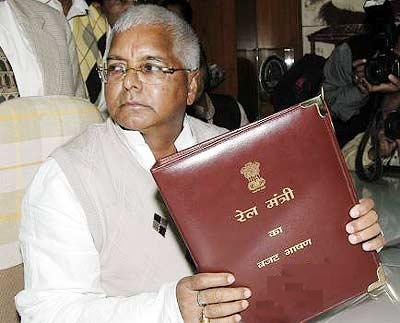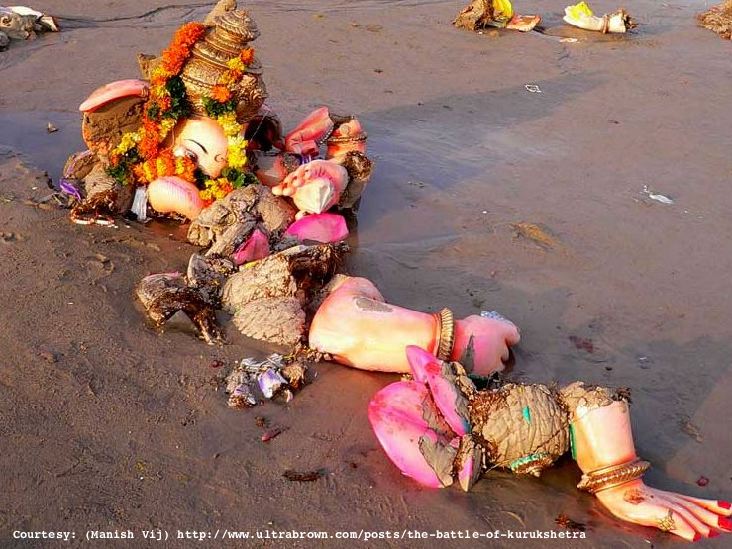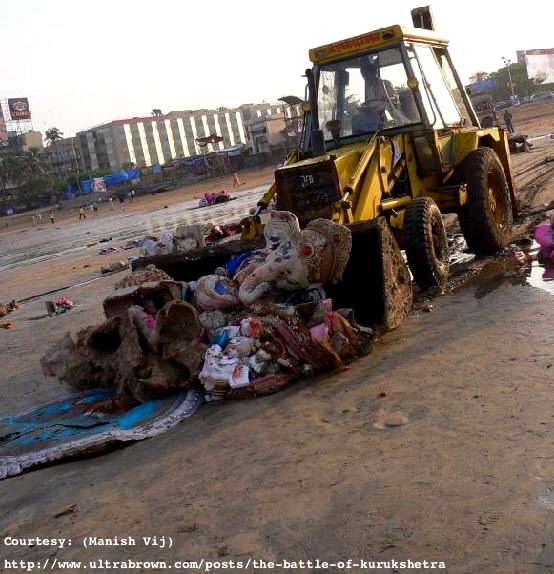Why is an Indian railway station dirty and a Korean one clean?
I was just watching a documentary on National Geographic channel and they were showing how they built the fastest electric train traveling a long distance throughout the country. The train stations were so clean!!!! I was wonderin why it would not happen in India?
says Lalu Yadav

Jhabua (Madhya Pradesh), Feb. 8 : Railway Minister Lalu Yadav today said that this year's rail budget would be 'people friendly'."I will be presenting the rail budget on February 26 keeping the common man in mind," Yadav said after Prime Minister Manmohan Singh had laid the foundation stone of the Dahod-Indore and Chhota Udaipur-Dhar railway lines here.
Best Answer -
The main drawback with majority of the population is attitude .We Indians in general consider public places as 'thier' or 'govt's' not as 'mine' or 'ours' and dont feel responsible. This is the plight of all our public properties and places.
Korea is less populated and more developed while India is densely populated and under developed. I have never been to Korea but I have seen that in Korean movies. The main reason I believe is that we Indians in general dont really take care of the public places and to top it the cleaners in duty are equally irresponsible. The number of dust bins are either inadequate or not present. If present that would be not be cleared in time. You might have seen how lethargic they are when they do thier work. Likewise approx. 3467 railway stations.
I dont live in India but I am very excited to go there every year but this is one thing that puts me off esp the railway station. To answer your question specifically, I dont want to be pessimistic and say that it wont happen in our country cos if there is an effort from each one of us then we can why not??? but in 100 years!!!. The reason being India has population from various walks of life. The govt is equally irresponsible in creating awareness. If you need to enlighten the poor & illiterate you need to create awareness not by writing on the walls of the station 'not to spit' but by using the visual media extensively.
You cant really compare two countries like Korea n India since everthing is different the population,size of the country, the priorities of the govt(ours is definitely the poverty issue) n various things. But definitely they can be really inspiring. We have all the basics things in life and probably more that we want the railway stations to go international now but with majority of the population living below poverty line the govt has to feed the hungry people and this should not be the priority. Lets keep it clean and hope for the best.
In Bombay, a lot of Ganesh idols are made by the humble artisans whose workshops come to life in the days leading up to the festival. The colors range from the orange hues of the majestic Siddhivinayak or the ornate, little Ganeshas all dressed up in pink dhotis and golden crowns. The Ganesh stays in the house like a much-loved guest. The homes that welcome the idol constantly carry the scent of incense and camphor. A corner of the house where Lord Ganesha sits looks all lit up and decorated. There is the rare abundance of modaks, the sweet cardamom flavored dumplings with a coconut filling that melts in your mouth. And then one day amidst melodious aartis and impassioned cries beseeching Ganpati Bappa to come again next year, the idol is immersed into the sea.
 When this tradition first began the idols were made of clay which when immersed in water would dissolve, returning the spirit of this deity to the depths of nature. But lately, especially in Bombay, this festival has gained commercial significance. Public celebrations have created a competition where communities are seen vying each year to hoist the biggest idols on their pedestals. Enormous funds are gathered by the locals and the largest, most colorful of sculptures is put up, much like an exhibit. While this practice has helped cultivate a sense of community, the idols themselves are no longer made from environment friendly clay. The murtis (idols) that are placed for the visual delight of the crowds are now made from Plaster Of Paris.
When this tradition first began the idols were made of clay which when immersed in water would dissolve, returning the spirit of this deity to the depths of nature. But lately, especially in Bombay, this festival has gained commercial significance. Public celebrations have created a competition where communities are seen vying each year to hoist the biggest idols on their pedestals. Enormous funds are gathered by the locals and the largest, most colorful of sculptures is put up, much like an exhibit. While this practice has helped cultivate a sense of community, the idols themselves are no longer made from environment friendly clay. The murtis (idols) that are placed for the visual delight of the crowds are now made from Plaster Of Paris.
Plaster Of Paris is easier to mould and the several intricate patterns that go onto a Ganesh idol are easier to carve on this material. Moreover, the increasing demand for Ganesh idols and the large sizes that are so popular make the artisans look towards the cheaper option. Plaster Of Paris is much cheaper than clay but unfortunately less soluble in water. As a result the Ganesh idol that has been treated like a beloved houseguest by so many faithful devotees, sits at the bottom of the ocean, slow disintegration of the plaster releasing toxic elements into the water. The chemicals used in painting the idol contain hazardous mercury and cadmium metals. As the magnificent four arms, golden crowns and loving brown eyes of the elephant god crumble into the seawater, the ocean's flora and fauna suffer from the sudden increase in acidity and toxicity of the water. For years this issue has been tap-danced around to protect religious sentiment. But the urgency of protecting the environment should probably hold more importance and urgency than people's religious sensitivities. Surely, educated men and women understand that to abuse the divine gift of nature is in no way a means of paying obeisance to a deity.
Those whose religious sentiments are hurt when it comes to protecting the environment have never taken a walk along the beaches in Bombay a day or two after the immersion (Anant Chaturdashi). A collection of pictures by Manish Vij shows the large disfigured, broken, scraped and dismembered Ganesh idols that float in with the sea debri onto the shore. A municipality truck arrives, gathers this debris like it would gather garbage and disposes it. Along with this debris are dead fish killed by the toxins and the high acidity of the seawater. So much for religious sentiment.
 The Ganesh Chaturthi festival is a time when communities unite and celebrate together. Nobody wants to lose out on the festive occasion. But finding a way to be kind to the environment while indulging in the festivities is a responsible thing to do. There are always devotees who want to have an environment friendly Ganesh Chaturthi and wonder what their options are. There are various options to buying a large Plaster Of Paris idol. In fact, Wikipedia outlines a few easy and feasible solutions to addressing this issue:
The Ganesh Chaturthi festival is a time when communities unite and celebrate together. Nobody wants to lose out on the festive occasion. But finding a way to be kind to the environment while indulging in the festivities is a responsible thing to do. There are always devotees who want to have an environment friendly Ganesh Chaturthi and wonder what their options are. There are various options to buying a large Plaster Of Paris idol. In fact, Wikipedia outlines a few easy and feasible solutions to addressing this issue:
<
The Girgaum area is famous for skilled artisans who use traditional and environmental friendly clay to make the idols. There are famous Ganeshotsav mandals that choose to make creative Ganesh replicas from flowers, paper mache, coconuts etc. The Ganeshotsav mandals can choose to give out a prize for the one who comes up with the most environmental friendly design for a Ganesh idol every year. Families can buy a smaller, clay Ganpati for their home. A small idol can be prayed to. Faith should not be incumbent on the size of the idol, should it?
Commercialization of religious festivals likely has a positive influence in nurturing communal sense but when the celebration ends and the environment suffers, people need to evaluate this problem and treat it like their own. After all, Lord Ganesha would not want the beautiful gift of natural resources to be exploited and abused in this manner. Surely our devotion should not be blind towards God's fine creations in our zeal to uphold his idol.
Korea is less populated and more developed while India is densely populated and under developed. I have never been to Korea but I have seen that in Korean movies. The main reason I believe is that we Indians in general dont really take care of the public places and to top it the cleaners in duty are equally irresponsible. The number of dust bins are either inadequate or not present. If present that would be not be cleared in time. You might have seen how lethargic they are when they do thier work. Likewise approx. 3467 railway stations.
And if you compare the flooring of the railway stations (if u have travelled thoroughout India) with developed countries we would actually require someone coming in the morning to the station and cleaning it with a wire brush or
something even harder to get rid of those 'paan' stains eeewww. And what about the toilets whoaaa !!! All we can do is to do our bit and to take care of our surrounding and dont be a part of that littering and spitting. India is a larger country with larger population n various problems to tackle. I wish our elected leaders had observation like you.
I dont live in India but I am very excited to go there every year but this is one thing that puts me off esp the railway station. To answer your question specifically, I dont want to be pessimistic and say that it wont happen in our country cos if there is an effort from each one of us then we can why not??? but in 100 years!!!. The reason being India has population from various walks of life. The govt is equally irresponsible in creating awareness. If you need to enlighten the poor & illiterate you need to create awareness not by writing on the walls of the station 'not to spit' but by using the visual media extensively.
Ganesha & The Globe: An Eco-Friendly Ganesh Chaturthi
Ganesh Chaturthi is one of my favorite festivals. Even now, away from home I can still remember the eve of Ganesh Chaturthi when the beautiful Ganesh idols would be welcomed into homes and residential communities. It marked the beginning of the festive season leading up to Diwali.
In Bombay, a lot of Ganesh idols are made by the humble artisans whose workshops come to life in the days leading up to the festival. The colors range from the orange hues of the majestic Siddhivinayak or the ornate, little Ganeshas all dressed up in pink dhotis and golden crowns. The Ganesh stays in the house like a much-loved guest. The homes that welcome the idol constantly carry the scent of incense and camphor. A corner of the house where Lord Ganesha sits looks all lit up and decorated. There is the rare abundance of modaks, the sweet cardamom flavored dumplings with a coconut filling that melts in your mouth. And then one day amidst melodious aartis and impassioned cries beseeching Ganpati Bappa to come again next year, the idol is immersed into the sea.

Plaster Of Paris is easier to mould and the several intricate patterns that go onto a Ganesh idol are easier to carve on this material. Moreover, the increasing demand for Ganesh idols and the large sizes that are so popular make the artisans look towards the cheaper option. Plaster Of Paris is much cheaper than clay but unfortunately less soluble in water. As a result the Ganesh idol that has been treated like a beloved houseguest by so many faithful devotees, sits at the bottom of the ocean, slow disintegration of the plaster releasing toxic elements into the water. The chemicals used in painting the idol contain hazardous mercury and cadmium metals. As the magnificent four arms, golden crowns and loving brown eyes of the elephant god crumble into the seawater, the ocean's flora and fauna suffer from the sudden increase in acidity and toxicity of the water. For years this issue has been tap-danced around to protect religious sentiment. But the urgency of protecting the environment should probably hold more importance and urgency than people's religious sensitivities. Surely, educated men and women understand that to abuse the divine gift of nature is in no way a means of paying obeisance to a deity.
Those whose religious sentiments are hurt when it comes to protecting the environment have never taken a walk along the beaches in Bombay a day or two after the immersion (Anant Chaturdashi). A collection of pictures by Manish Vij shows the large disfigured, broken, scraped and dismembered Ganesh idols that float in with the sea debri onto the shore. A municipality truck arrives, gathers this debris like it would gather garbage and disposes it. Along with this debris are dead fish killed by the toxins and the high acidity of the seawater. So much for religious sentiment.

<
1. Return to the traditional use of natural clay idols and immerse the idol in a bucket of water at home.
2. Use of a permanent idol made of stone and brass, used every year and a symbolic immersion only.
3. Recycling of plaster idols to repaint them and use them again the following year.
4. Ban on the immersion of plaster idols into lakes, rivers and the sea.
5. Creative use of other biodegradable materials such as paper mache to create Ganesh idols.
6. Encouraging people to immerse the idols in tanks of water rather than in natural water bodies.
The Girgaum area is famous for skilled artisans who use traditional and environmental friendly clay to make the idols. There are famous Ganeshotsav mandals that choose to make creative Ganesh replicas from flowers, paper mache, coconuts etc. The Ganeshotsav mandals can choose to give out a prize for the one who comes up with the most environmental friendly design for a Ganesh idol every year. Families can buy a smaller, clay Ganpati for their home. A small idol can be prayed to. Faith should not be incumbent on the size of the idol, should it?
Commercialization of religious festivals likely has a positive influence in nurturing communal sense but when the celebration ends and the environment suffers, people need to evaluate this problem and treat it like their own. After all, Lord Ganesha would not want the beautiful gift of natural resources to be exploited and abused in this manner. Surely our devotion should not be blind towards God's fine creations in our zeal to uphold his idol.






















